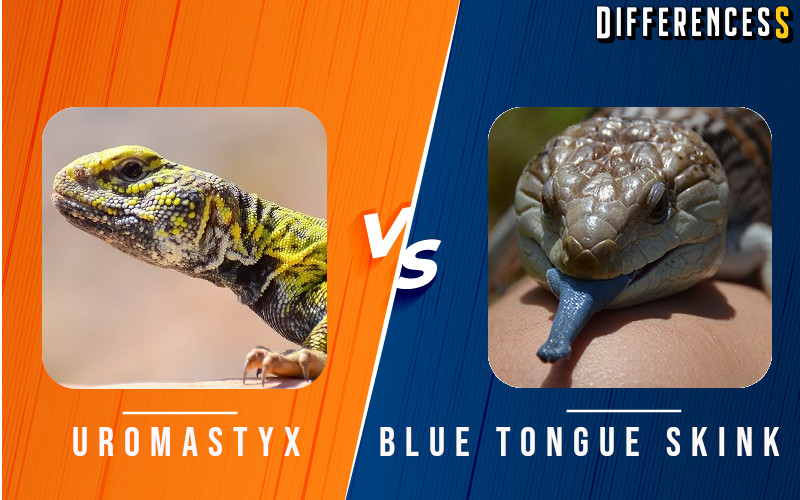Uromastyx and Blue Tongued Skinks are distinctive lizards of the reptile family.
They are often termed exotic pets by reptile lovers. But what would happen if a faceoff happens between them, Who would win?
To determine the winner of the faceoff, we need to look into their physical traits, behaviour, habitat, diet etc. Let’s know about them.
Post Contents
How Uromastyx Looks?
North African Spiny-tailed lizards or Uromastyx or Mastigure belongs to the Agamidae family.
The average body length of an adult spiny-tailed lizards is about 40-43 cm and weigh about 40 gm.
As the name suggests “spiny-tailed” these lizards have stout tail having protective rings of spines on their tails.
Uromastyx has a blunt head, large and spiny tails; they have a flattened torso.
The colouration of lizards vary from mottled red, orange, green, yellow, grey to brown;
this scale colouration becomes most vivid when they became sexually mature.
Both males and females are equal in size; however, males have more colour variations.
What are the physical traits of Blue Tongued Skin?
Eastern Blue-Tongued skink as the name suggests these skinks have a long blue tongue;
when they are threatened they brandish their UV reflective, cobalt tongue as a display to defence.
The average body length of blue-tongued skink is about 43-55 cm and their weight ranges between 283-510 gm.
Their skin is covered with fish-like scales having smooth skin. skinks have a robust and cylindrical body with a short leg.
The colouration of skinks is grey, brown having dark brown and cream blotches.
However, Juvenile skinks have more vivid colouration which helps them in camouflaging.
How Spiny-tailed lizard behaves?
Spiny-tailed lizards are very aggressive; they are intolerant even to their species.
They are aggressive towards intruders; they even kill or eat their siblings.
Fierce fights between skinks are quite common; they bite the sides of their opponents which leave white scars.
Uromastyx is diurnal species; they are most active during the day. They also hibernate in winter for 2-5 months.
What are the behavioural traits of blue-tongued skink?
Blue-tongued skinks are also aggressive but in comparison to spiny-tailed lizards, they are quite docile and tameable.
They are shy by nature and seldom goes far from their shelters.
When they are threatened they puff their bodies to look bigger, hisses and warn the predator by brandishing their blue tongue.
Like other lizards, they can also leave their tail to distract the predator and run away; after some time tail grows back again.
What does a spiny-tailed lizard eat?
Spiny-tailed lizards are primarily herbivores; however, they do eat ants and beetles and high fibrous desert plants.
What do blue tongue skink eat?
Blue-Tongued skinks are omnivores; they feed on small insects, lizards, leaves, fruit etc.
Where are spiny-tailed lizard found?
Spiny-tailed lizards are found in Saharan deserts, Saharan Atlas, Mauritania, Algeria, and Egypt.
Where are blue-tongued skink found?
Blue-tongued skins are indigenous to Australia, Tasmania and New Guinea.
Which do spiny-tailed lizard lives?
Spiny-tailed lizards live in arid and semi-arid regions.
Where does the blue tongued skink live?
Blue-tongued skinks live in woodlands, scrublands and semi-desert areas.
Amazing Facts:
- Adult Blue-tongued skinks shed their scales every six weeks.
- Blue-tongued Skinks don’t have well-formed teeth but they can bite fiercely.
Face-off: Uromastyx vs Blue-tongue skink
From the above information, we got a lot of information about Uromastyx and blue-tongued skin, now it’s time for the faceoff. On the one hand, we have Uromastyx which has its spiny-tailed lizard as a weapon whereas its rival Blue-Tongued skink overweighs the Uromastyx and has strong jaws.
When a Blue-Tongue skink attacks the Uromastyx, Uromastyx would retaliate and try to blue-tongue skink with its spiny-tail; however, it would be difficult for Uromastyx to take down a heavy and agile skink.
If Uromastyx gets in the jaws of Blue-Tongued skink it would prove fatal and Uromastyx might die, so Blue-Tongued skink is the winner of this battle. What do you think who would have won?
Comparison Table: Uromastyx vs Blue-Tongued Skink
| Comparison Heads | Uromastyx | Blue-Tongued Skink |
| Kingdom | Animalia | Animalia |
| Phylum | Chordata | Chordata |
| Class | Reptilia | Reptilia |
| Order | Squamata | Squamata |
| Family | Cordylidae | Scincidae |
| Genus | Cordylus | Tiliqua |
| Species | C.Tropidosternum | T.Scincoides |
| Weight | About 40 gm | 283-510 gm |
| Body Length | 40-43 cm | 43-55 cm |
| Habitat | Arid and Semi-arid regions | Woodlands, Scrublands and Semi-desert areas |
| Life Span | 20-25 years | 15-20 years |
